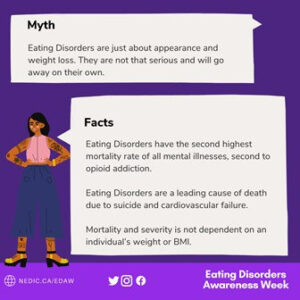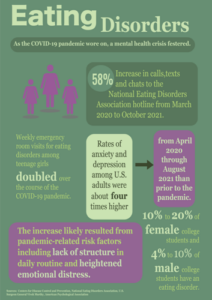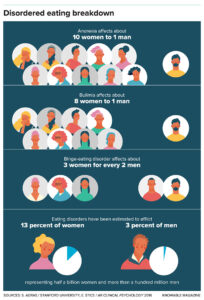Statistics on Eating Disorder Trends in the United States
Eating disorders involve extreme emotions, attitudes, and behaviors involving weight and food. Some include anorexia nervosa, binge eating, and bulimia.
Types of Eating Disorders
Binge eating is when someone consumes significantly more food in a shorter timeframe than usual. During these episodes, the individual might experience a sense of not being in control.1
Causes
While the exact cause of binge eating is not clear, it’s worth noting that it can sometimes start after a period of strict dieting. Binge eating might happen independently or alongside another eating disorder like bulimia.
Signs & Symptoms
A person who binge eats often:
- Eats excessive numbers of calories in one sitting, often alone
- Feeling unable to control their eating
- Eating very quickly
- Eating even when they’re not hungry
- Snacks, in addition to eating three meals a day
- Overeats throughout the day
- Feeling upset about their eating behaviors
While food addiction is not yet classified in DSM-5, it has gained attention and interest in both the media and scientific community, with an increasing number of studies and reviews exploring its diagnostic, neurobiological, and practical aspects. Research has found that specific highly palatable foods rich in sugar, fat, and salt can activate the brain’s reward and pleasure centers similar to addictive drugs. This stimulation releases dopamine and other feel-good chemicals, leading to cravings and a diminished ability to control eating behavior. Compulsive overeating, a form of behavioral addiction, can result in a preoccupation with food, excessive time spent on overeating or anticipating its emotional effects. Additionally, individuals with food addiction may develop a tolerance, requiring larger amounts of food to achieve the same level of satisfaction. Understanding food addiction sheds light on the complexities of overeating and offers insights into effective strategies for managing this behavior.2
The Difference Between Food Addiction And Binge-eating Disorder (BED):
Despite the similarities, BED and drug addictions also differ in important ways. BED focuses on consuming a large amount of food in a specific time and feeling out of control, while food addiction focuses less on specific time periods and more on consuming more or more frequently than intended. Food addiction is considered substance addiction, while binge-eating disorder is considered behavioral addiction3.
Anorexia nervosa is an eating disorder characterized by excessive weight loss beyond what’s considered healthy for one’s age and height. Persons with anorexia typically avoid or severely restrict food.1
Those affected by this condition often have a strong fear of gaining weight, even if they’re already underweight. They might engage in excessive dieting, exercise, or use other methods to lose weight.
Causes
The exact causes of anorexia nervosa are not known. Many factors are involved, such as genes and hormones, and social attitudes that promote certain body types.
Risk factors for anorexia include:
- Being more worried about, or paying more attention to, weight and shape
- Having an anxiety disorder as a child
- Having a negative self-image
- Having eating problems during infancy or early childhood
- Having certain social or cultural ideas about health and beauty
- Trying to be perfect or overly focused on rules
Anorexia usually begins during the teen years or young adulthood. Although more common among people who identify as women, anorexia affects all gender identities.
Signs & Symptoms
Symptoms of Anorexia Nervosa include:
- Have an intense fear of gaining weight or becoming fat, even when they are underweight
- Refuse to keep weight at what is considered normal for their age, sex, height, and development.
- Have a distorted sense of body image, be very focused on body weight or shape, and are unable to understand the seriousness of weight loss
- Physical health changes such as menstrual period irregularities
People with anorexia may severely limit the amount of food they eat, or they may eat and then make themselves throw up. Other behaviors include:
- Cutting food into small pieces or moving them around the plate instead of eating
- Exercising all the time, even if they are hurt
- Going to the bathroom right after meals
- Refusing to eat around other people
- Using pills to make themselves urinate, have a bowel movement, or decrease their appetite
Other symptoms of anorexia may include:
- Blotchy or yellow skin that is dry and covered with fine hair
- Confused or slow thinking, along with poor memory or judgment
- Depression
- Dry mouth
- Extreme sensitivity to cold (wearing several layers of clothing to stay warm)
- Loss of bone strength, muscle, and body fat
- Fatigue
Bulimia is an illness in which a person binges on food, or has regular episodes of overeating, and feels a loss of control over their eating. Afterward, they resort to various techniques to avoid gaining weight, like vomiting or using laxatives.1
Typically, the person recognizes that their eating habits are unusual and might feel fearful or guilty after bingeing and purging. This disorder is more common among adolescent girls and young women.
Causes
The exact cause of bulimia is unknown. Genetics, psychological, trauma, family, society, or cultural factors may play a role. Bulimia is likely due to more than one factor.
Signs & Symptoms
Individuals with bulimia frequently consume significant quantities of calorie-rich foods, often in a concealed manner. These episodes can evoke a sensation of being unable to manage their eating. These patterns of eating and bingeing might happen multiple times a day for an extended period, spanning several months or even longer.
It is common that binge eating will lead to a feeling of self-disgust, which causes purging to prevent weight gain, bringing a sense of relief.
Bulimia may include:
- Forcing oneself to vomit
- Excessive exercise
- Using laxatives, enemas, or diuretics (water pills)
Symptoms include:
- Chronically inflamed and sore throat
- Increasingly sensitive and decaying teeth (due to stomach acid when vomiting)
- Severe dehydration (electrolyte imbalances can lead to heart attack or stroke)
- Suddenly eating large amounts of food or buying large amounts of food that disappear right away
- Regularly going to the bathroom right after meals
- Throwing away packages of laxatives, diet pills, emetics (drugs that cause vomiting), or diuretics
For more information, please visit: https://pubmed.ncbi.nlm.nih.gov/31744566/
1Substance Abuse and Mental Health Services Administration https://www.samhsa.gov/mental-health/eating-disorders
2Adams RC, Sedgmond J, Maizey L, Chambers CD, Lawrence NS. Food Addiction: Implications for the Diagnosis and Treatment of Overeating. Nutrients. 2019 Sep 4;11(9):2086. doi: 10.3390/nu11092086. PMID: 31487791; PMCID: PMC6770567. https://www.ncbi.nlm.nih.gov/pmc/articles/PMC6770567/
3Gearhardt AN, White MA, Potenza MN. Binge eating disorder and food addiction. Curr Drug Abuse Rev. 2011 Sep;4(3):201-7. doi: 10.2174/1874473711104030201. PMID: 21999695; PMCID: PMC3671377. https://www.ncbi.nlm.nih.gov/pmc/articles/PMC3671377/








